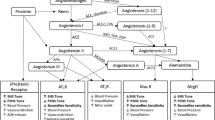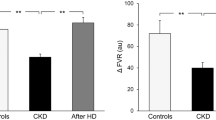Abstract
Autonomic function is disordered in cardiovascular disease states such as chronic heart failure (CHF) and hypertension. Interactions between the renin-angiotensin-aldosterone system (RAAS) and the sympathetic nervous system (SNS) may potentially occur at a number of sites. These include central sites (eg, rostral ventrolateral medulla), at the level of baroreflex control, and at the sympathetic prejunctional angiotensin II receptor 1 (AT1) receptor, which is facilitatory for norepinephrine release from the sympathetic nerve terminal. Therefore, drugs that block the RAAS may be expected to improve autonomic dysfunction in cardiovascular disease states. In order to test the hypothesis that RAAS inhibition directly reduces SNS activity, a pithed rat model of sympathetic stimulation has been established. In this model, an increase in frequency of stimulation results in a pressor response that is sympathetically mediated and highly reproducible. This pressor response is enhanced in the presence of angiotensin II and is reduced in the presence of nonselective AIIRAs that block both AT1 and AT2 receptor subtypes (eg, saralasin). AT1-selective antagonists have also been studied in this model, at pharmacologically relevant doses. In one such study, only the AT1 blocker eprosartan reduced sympathetically stimulated increases in blood pressure, whereas comparable doses of losartan, valsartan, and irbesartan did not. The reason(s) for the differences between eprosartan and other agents of this class on sympathetic modulation are not clear, but may relate to the chemical structure of the drug (a non-biphenyl tetrazole structure that is chemically distinct from the structure of other AIIRAs), receptor binding characteristics (competitive), or unique effects on presynaptic AT1 receptors.
Similar content being viewed by others
References
Rahn KH, Barenbrock M, Hausberg M: The sympathetic nervous system in the pathogenesis of hypertension. J Hypertens 1999, 17(suppl 3):S11-S14.
Esler M, Jennings G, Korner P, et al.: Total, and organ-specific, noradrenaline plasma kinetics in essential hypertension. Clin Exp Hypertens [A] 1984, 6:507–521.
Floras JS, Hara K: Sympathoneural and haemodynamic characteristics of young subjects with mild essential hypertension. J Hypertens 1993, 11:647–655.
Julius S: The evidence for a pathophysiologic significance of the sympathetic overactivity in hypertension. Clin Exp Hypertens 1996, 18:305–321.
Guzzetti S, Dassi S, Pecis M, et al.: Altered pattern of circadian neural control of heart period in mild hypertension. J Hypertens 1991, 9:831–838.
Floras JS: Clinical aspects of sympathetic activation and parasympathetic withdrawal in heart failure. J Am Coll Cardiol 1993, 22(suppl A):72A-84A.
Grassi G, Esler M: How to assess sympathetic activity in humans. J Hypertens 1999, 17:719–734.
Krum H: Sympathetic activation and the role of beta-blockers in chronic heart failure. Aust N Z J Med 1999, 29:418–427.
Colucci WS: Molecular and cellular mechanisms of myocardial failure. Am J Cardiol 1997, 80:15L-25L.
Cohn JN, Levine TB, Olivari MT, et al.: Plasma norepinephrine as a guide to prognosis in patients with chronic congestive heart failure. N Engl J Med 1984, 311:819–823.
Mancia G, Grassi G, Giannattasio C, Seravalle G: Sympathetic activation in the pathogenesis of hypertension and progression of organ damage. Hypertension 1999, 34:724–728.
Palatini P: Elevated heart rate as a predictor of increased cardiovascular morbidity. J Hypertens 1999, 17(suppl 3):S3-S10.
Head GA: Role of AT1 receptors in the central control of sympathetic vasomotor function. Clin Exp Pharmacol Physiol Suppl 1996, 3:S93-S98.
Hirooka Y, Potts PD, Dampney RA: Role of angiotensin II receptor subtypes in mediating the sympathoexcitatory effects of exogenous and endogenous angiotensin peptides in the rostral ventrolateral medulla of the rabbit. Brain Res 1997, 772:107–114.
Murakami H, Liu JL, Zucker IH: Blockade of AT1 receptors enhances baroreflex control of heart rate in conscious rabbits with heart failure. Am J Physiol 1996, 271:R303-R309.
Brooks DP, Ruffolo RR Jr: Pharmacological mechanism of angiotensin II receptor antagonists: implications for the treatment of elevated systolic blood pressure. J Hypertens Suppl 1999, 17:S27-S32.
Cox SL, Ben A, Story DF, Ziogas J: Evidence for the involvement of different receptor subtypes in the pre-and postjunctional actions of angiotensin II at rat sympathetic neuroeffector sites. Br J Pharmacol 1995, 114:1057–1063.
Guimaraes S, Paiva MQ, Moura D: Different receptors for angiotensin II at pre-and postjunctional level of the canine mesenteric and pulmonary arteries. Br J Pharmacol 1998, 124:1207–1212.
Krum H, Goldsmith RL: Effects of pharmacological therapy on autonomic function in patients with chronic heart failure. Editorials Cardiol 1995, 1:167–176.
McKelvie RS, Yusuf S, Pericak D, et al.: Comparison of candesartan, enalapril, and their combination in congestive heart failure: randomized evaluation of strategies for left ventricular dysfunction (RESOLVD) pilot study. The RESOLVD Pilot Study Investigators. Circulation 1999, 100:1056–1064.
Middlekauff HR: Mechanisms and implications of autonomic nervous system dysfunction in heart failure. Curr Opin Cardiol 1997, 12:265–275.
Grassi G, Turri C, Dell‘Oro R, et al.: Effect of chronic angiotensin converting enzyme inhibition on sympathetic nerve traffic and baroreflex control of the circulation in essential hypertension. J Hypertens 1998, 16(12 Pt 1):1789–1796.
Worck RH, Ibsen H, Frandsen E, Dige-Petersen H: AT 1 receptor blockade and the sympathoadrenal response to insulininduced hypoglycemia in humans. Am J Physiol 1997, 272(3 Pt 1):E415-E421.
Noll G, Wenzel RR, de Marchi S, et al.: Differential effects of captopril and nitrates on muscle sympathetic nerve activity in volunteers. Circulation 1997, 95:2286–2292.
Clemson B, Gaul L, Gubin SS, et al.: Prejunctional angiotensin II receptors. Facilitation of norepinephrine release in the human forearm. J Clin Invest 1994, 93:684–691.
Lyons D, Roy S, Kinirons M, Swift CG: Selective AT 1 receptor antagonism enhances sympathetically mediated vasoconstriction in the human forearm [abstract 6A.5]. Presented at the First International Symposium on Angiotensin II Antagonists, October 1997, London.
Lyons D, Roy S, O‘Byrne S, Swift CG: ACE inhibition: postsynaptic adrenergic sympatholytic action in men. Circulation 1997, 96:911–915.
Ohlstein EH, Brooks DP, Feuerstein GZ, Ruffolo RR Jr: Inhibition of sympathetic outflow by the angiotensin II receptor antagonist, eprosartan, but not by losartan, valsartan or irbesartan: relationship to differences in prejunctional angiotensin II receptor blockade. Pharmacology 1997, 55:244–251.
Balt JC, Mathy MJ, Pfaffendorf M, van Zwieten PA: Inhibition of angiotensin-induced facilitation of sympathetic neurotransmission in the pithed rat: a comparison between losartan, irbesartan, telmisartan and captopril. J Hypertens 2001, 19:465–473.
Balt JC, Mathy MJ, Pfaffendorf M, van Zwieten PA: Blockade of both pre-and post-synaptically located AT1 receptors by valsartan, candesartan, eprosartan and embusartan. Naunyn Schmiedeberg‘s Arch Pharmacol 2001; 363(suppl):R75.
Brooks DP, Ohlstein EH, Ruffolo RR Jr: Pharmacology of eprosartan, an angiotensin II receptor antagonist: exploring hypotheses from clinical data. Am Heart J 1999, 138(3 Pt 2):246–251.
Edwards RM, Aiyar N, Ohlstein EH, et al.: Pharmacological characterization of the nonpeptide angiotensin II receptor antagonist, SK& F 108566. J Pharmacol Exp Ther 1992, 260:175–181.
Brooks DP, Ruffolo RR Jr: Pharmacological mechanism of angiotensin II receptor antagonists: implications for the treatment of elevated systolic blood pressure. J Hypertens Suppl 1999, 17:S27-S32.
Sega R: Efficacy and safety of eprosartan in severe hypertension. Eprosartan Multinational Study Group. Blood Press 1999, 8:114–121.
Author information
Authors and Affiliations
Rights and permissions
About this article
Cite this article
Krum, H. Differentiation in the Angiotensin II Receptor 1 blocker class on autonomic function. Current Science Inc 3, S17–S23 (2001). https://doi.org/10.1007/s11906-001-0067-x
Issue Date:
DOI: https://doi.org/10.1007/s11906-001-0067-x




